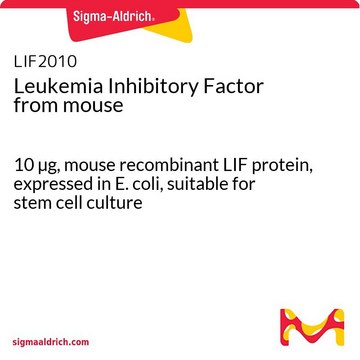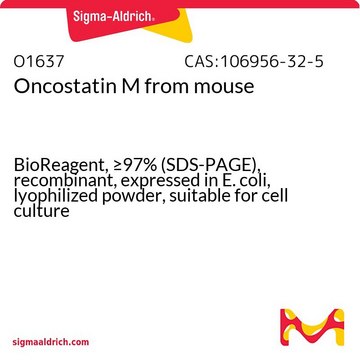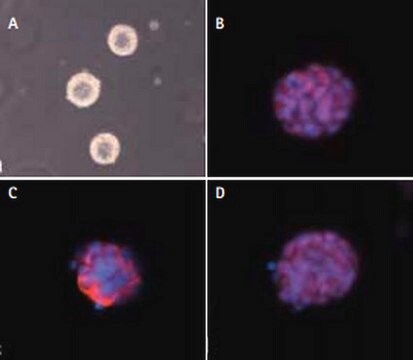ESG1106
ESGRO® Recombinant Mouse LIF Protein
ESGRO Leukemia Inhibitory Factor (LIF) supplement for mouse ES cell culture. Each vial contains 10^6 units/ml
Synonim(y):
Mouse LIF, Mouse Leukemia Inhibitory Factor, Murine LIF, Murine LIF, Mouse LIF, mLIF, mLIF
About This Item
Polecane produkty
Poziom jakości
Próba
>95% (active component mLIF, SDS-PAGE)
Formularz
liquid
producent / nazwa handlowa
Chemicon®
stężenie
1000000 units/mL
metody
cell culture | stem cell: suitable
moc wejściowa
sample type: mouse embryonic stem cell(s)
sample type induced pluripotent stem cell(s)
numer dostępu NCBI
numer dostępu UniProt
Warunki transportu
wet ice
informacje o genach
mouse ... LIF(16878)
Opis ogólny
Zastosowanie
SUGGESTED PROTOCOLS:
ES Cells: In D3 and MBL-1 pluripotential ES cell cultures it is routinely found that 1000 U of ESGRO Supplement per 1.0 mL of tissue culture media is required to maintain ES cells with a stem cell phenotype. Similar concentrations of mLIF have also been used for germline transmission of genetically altered ES cells (E3).
At the recommended concentration 107 units of ESGRO Supplement is sufficient for 10.0 L of tissue culture media and 106 units of ESGRO Supplement is sufficient for 1.0 L of tissue culture media.
Postać fizyczna
Uwaga dotycząca przygotowania
Przechowywanie i stabilność
Komentarz do analizy
Embryonic Stem Cell Assay: Differentiation inhibition at 1000 units/mL Murine myeloid leukemic, M1 Assay: Specific Activity >/= 108 units/mg
Informacje prawne
Kod klasy składowania
12 - Non Combustible Liquids
Klasa zagrożenia wodnego (WGK)
WGK 2
Temperatura zapłonu (°F)
Not applicable
Temperatura zapłonu (°C)
Not applicable
Certyfikaty analizy (CoA)
Poszukaj Certyfikaty analizy (CoA), wpisując numer partii/serii produktów. Numery serii i partii można znaleźć na etykiecie produktu po słowach „seria” lub „partia”.
Masz już ten produkt?
Dokumenty związane z niedawno zakupionymi produktami zostały zamieszczone w Bibliotece dokumentów.
Klienci oglądali również te produkty
Produkty
Czynnik hamujący białaczkę (LIF) jest czynnikiem wzrostu komórek macierzystych stosowanym do hodowli in vitro pluripotencjalnych mysich embrionalnych komórek macierzystych (komórek ES).
Zapoznaj się z rodzajami komórek macierzystych, w tym multipotencjalnymi komórkami macierzystymi, pluripotencjalnymi komórkami macierzystymi i iPSC oraz ich zastosowaniami w podstawowych badaniach nad komórkami macierzystymi, terapii komórkami macierzystymi i modelowaniu chorób.
Naive pluripotent stem cells are located within the epiblast of mature blastocysts. These primitive “ground-state” cells may be cultured in vitro using specialized media and small molecule inhibitors.
Protokoły
Stem Cell protocols for cryopreservation, thawing of cryopreserved stem cells and media preparation.
This page covers the indirect co-culture of embryonic stem cells with embryonic fibroblasts.
Nasz zespół naukowców ma doświadczenie we wszystkich obszarach badań, w tym w naukach przyrodniczych, materiałoznawstwie, syntezie chemicznej, chromatografii, analityce i wielu innych dziedzinach.
Skontaktuj się z zespołem ds. pomocy technicznej










